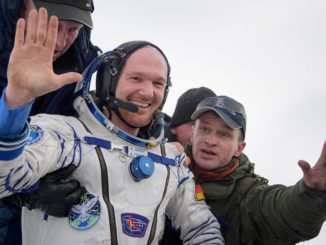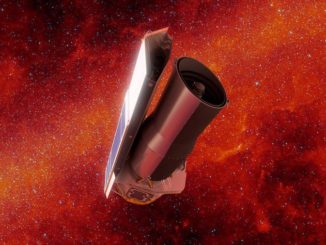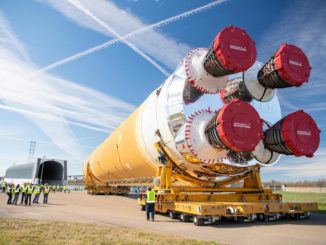
A troublesome liquid oxygen valve on the Space Launch System’s first flight-rated core stage will keep NASA from performing a second test-firing of the rocket’s four main engines this week.
NASA hoped to conduct the second hotfire test on SLS core stage Thursday, but the agency announced Monday that the engine firing will be postponed to evaluate a misbehaving valve in the rocket’s propulsion system.
The space agency said Monday that engineers identified the problem over the weekend. One of eight “prevalves” in the core stage propulsion system was not working properly, NASA said.
The prevalve supplies liquid oxygen to one of the rocket’s four RS-25 main engines. The engines are left over from the space shuttle program, and consume liquid hydrogen fuel in combination with super-cold liquid oxygen. All eight prevalves functioned properly during the first SLS core stage hotfire test Jan. 16, officials said.
“NASA and the core stage lead contractor Boeing will identify a path forward in the days ahead and reschedule the hot fire test that was originally scheduled for Feb. 25,” NASA said Monday.
The Jan. 16 hotfire test was supposed to last more than eight minutes, but the four RS-25 engines shut down a little more than a minute after ignition. Engineers traced the cause of the premature shutdown to a hydraulic system parameter that tripped an overly-conservative setting for the test, the last phase of a “Green Run” test and checkout campaign for the SLS core stage at NASA’s Stennis Space Center in Mississippi.
The core stage hydraulics drive actuators that pivot, or gimbal, the four RS-25 engines to steer the rocket after liftoff. The Space Launch System will fly with two solid rocket boosters mounted on each side of the 212-foot-tall (64.6-meter) core stage. An upper stage and Orion crew capsule on top of the core stage will bring the total launcher height to 322 feet (98 meters) tall.
NASA officials decided to redo the Green Run test-firing after the early cutoff last month. Managers want to get at least four minutes of run time on the RS-25 engines on the second hotfire test to gather enough data to build confidence in the rocket’s performance before shipping the stage to the Kennedy Space Center in Florida for launch preparations.
But the goal for the second hotfire test is to burn the engines for more than eight minutes, the duration they will fire on a real SLS flight.
Kathy Lueders, associate administrator for NASA’s human spaceflight division, said Wednesday that engineers were having trouble getting the liquid oxygen prevalve to fully open during checkouts before the second Green Run hotfire test.
“It’s very frustrating,” Lueders said in a panel discussion at the 47th Spaceport Summit.
“On your LOX (liquid oxygen) system, if you’re trying to run your engines at the power level we’re trying to run our engines, you need to have that prevalve open,” she said.
The Green Run hotfire test has been delayed more than six months since the SLS core stage arrived at Stennis in January 2020. A temporary suspension of work caused by the COVID-19 pandemic initially delayed preparations for the test, and a series of hurricanes and tropical storms that impacted the Gulf Coast last year also slowed work at the Stennis Space Center.

Engineers aimed to perform the hotfire test before the end of the year, but a problem during a fueling test in December pushed the engine firing into January. With the most recent delay, the earliest the full-duration core stage test-firing is some time in March.
The first SLS test launch will carry an unpiloted Orion crew capsule into space on NASA’s Artemis 1 mission. The Orion spacecraft will fly into orbit around the moon on a multi-week test flight before returning to Earth for a splashdown in the Pacific Ocean. If successful, the mission will pave the way for Artemis 2, the first crewed SLS/Orion mission, to carry four astronauts around the moon and back to Earth as soon as 2023.
The Artemis program is NASA’s initiative to return astronauts to the moon. NASA was tasked by the Trump administration with landing a crew near the south pole of the moon by the end of 2024. The Biden administration has expressed support for the Artemis program, but has not set a timetable for a crewed lunar landing mission.
The 2024 schedule goal was already slipping away before the end of the Trump administration. Congress approved only a fraction of the funding NASA requested in fiscal year 2021 for the Artemis program’s human-rated lunar lander development.
Lueders, a former manager of NASA’s commercial crew program, said the SLS Green Run delays were “very, very tough.”
“This is the one last piece that we have waiting for us to get down to the Cape for us to go fly,” Lueders said.
She said NASA is still “hoping” to fly the first SLS rocket at the end of this year.
“Like I used to say with the commercial crew program, we’re going to fly when we’re ready,” Lueders said Wednesday.
Email the author.
Follow Stephen Clark on Twitter: @StephenClark1.



